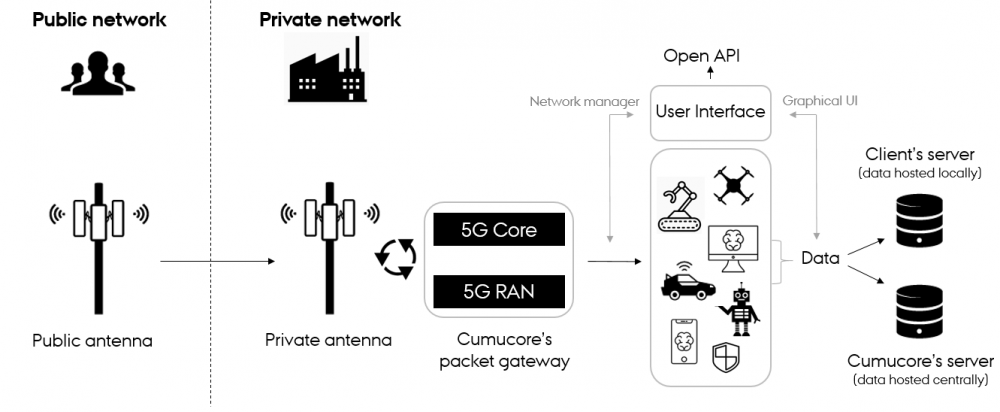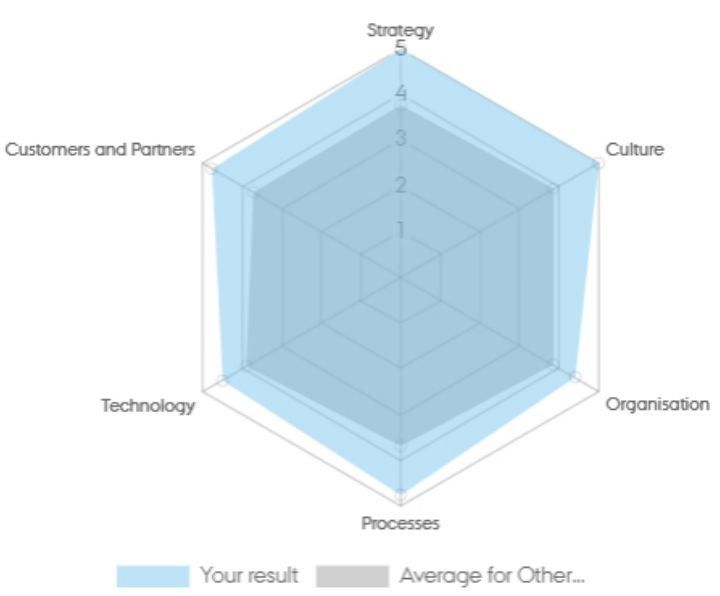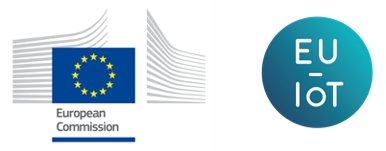
Terminal Link
ID: 4436
July 29, 2022
Digital platform connects all port industry equipment and systems for improvement of performance and efficiency.
ID: 3896
January 18, 2022
Cumucore works to enable Next Generation mobile private networks by providing flexible and affordable mobile services that connect the world. The company was founded in 2015 and is headquartered in Helsinki, Finland from where they deliver 4G and 5G mobile packet core with reliable and easily compatible software based on a mobile core for small-scale private LTE[1] and industrial deployments. The solutions provided by Cumucore simplify mobile networks in the cloud or on-site while maintaining connection performance, security and efficiency, and allow value adding applications and services to flow through pure software networks.
Cumucore responds to the need for connectivity posed by actors, especially in the verticals of Industry 4.0, autonomous logistics, and media. The software solution meets the communications requirements of all industry verticals as it is 3GPP[2] compliant and designed to support a broad variety of use case scenarios and deployment sizes. In addition to the software solution, Cumucore offers also hardware components and provides consultancy services, allowing the company to outsource deployment, management, and maintenance of the mobile cloud system.

The incentive of Cumucore to develop a solution that optimally facilitates the use of IoT- empowered technologies derives from a global ambition of fully connecting the world. By providing flexible and affordable next generation connectivity for everyone, Cumucore strives to enable the industrial digitalisation and thereby increase the efficiency of actors in all verticals.
“We moved towards 5G mainly with the idea that we could democratize the network.”
Jose Costa-Requena, Chief Technology Officer at Cumucore
Starting as a spin-off company from Aalto University in 2015, Cumucore was among the first actors in the telecommunications domain to develop a standalone (SA) solution of 5G connectivity with time-sensitive networking (TSN) technology, 5G Local Area Networks (5GLAN) and data analytics functions. This comes in handy in today’s connected society, where users demand superior connectivity that allows them to run multiple applications and services anytime and anywhere. In the past, the network was mainly consumer-oriented, whereas today, the demand for connectivity is increasingly driven by industrial environments. This development has shifted the needs of the users from large public networks to smaller private networks, while at the same time, setting high expectations to the capacity, stability and security of the network. With this paradigm, companies retain control of network resource allocation, facilitate M2M communication, and ensure that critical data remains on-site. Fulfilment of these expectations necessitates private 5G networks.
“There is a need. And there is no existing business model that the companies can deliver.”
Mika Skarp, Product Manager at Cumucore
To this end, Cumucore’s solution covers secure and simple 5G SA and 4G LTE connectivity. These solutions provide uncompromised network performance, which enables users to deploy novel technology applications such as real-time automation and augmented reality which can be used to facilitate the use of drones, automated guided vehicles and robots, and warehouse and asset tracking in complex industrial infrastructures.

The solution provided by Cumucore is a mobile packet core including all standard network functions. The 5G mobile network essentially consists of three elements: a radio element (antennas), a transport element (RAN [3]), and a packet core, which is basically the brains of that network.
The disruptive trait of Cumucore’s packet core is that it integrates Network Function Virtualization (NFV) and Software Defined Networking (SDN).
Cumucore’s solution is fully virtualized and can be run either from the cloud, meaning that the software and data is hosted centrally on Cumucore’s server, OR it can be run on-premises, meaning that the software and data is hosted locally on the client’s server at the edge of the network.

The private 5G network empowers the advanced technologies deployed by the client organisation, and a user interface, which is also part of the solution. The interface has two main functionalities. The first functionality is a graphical presentation of network data, and the second is the software that provides the ability to manage the network for various purposes, such as register devices, assign the SIM cards used when connecting to the network, create network groups and integrate with the client’s existing systems, services, and applications.
“We deliver a generic connectivity infrastructure. Then other services or applications can be deployed and integrated on top of that.”
Jose Costa-Requena, Chief Technology Officer at Cumucore
Via an open API, the solution thereby integrates well with existing business operations of the user.
Cumucore’s solution further comprise “network slicing” in the mobile packet core, which allows managers of the network to define groups of devices within the network and then restrict certain groups to access only certain parts of the network. This is an essential and rather unique attribute that is requested by organisations to ensure proper handling of sensitive data.
“One thing that makes this appealing, is that their data is local – it does not go into the public cloud.”
Mika Skarp, Product Manager at Cumucore
With a growing number of devices and explosion of data comes a societal need for new network performance levels. Connectivity has evolved from providing access to the internet to powering complex infrastructures. This development has increased congestion in the network, and 4G is reaching the technical limits for the amount and speed of data it is able to transfer.
“That is one of the major shifts in mobile technology. Now the IoT becomes an integral part of mobile communication.”
Jose Costa-Requena, Chief Technology Officer at Cumucore
Previous releases of the network, such as 2G, 3G and 4G, were configured to deliver download capacity because the majority of data was transmitted to end-users and consumer devices. Today, however, data is increasingly transmitted to industrial environments and far more technologically advanced devices.
“With IoT, the machines are the ones that are sending data to other machines in the network. So, in that sense, the communications should be able to handle this kind of a new paradigm.”
Jose Costa-Requena, Chief Technology Officer at Cumucore
To foster the growth of data-driven industries, 5G will be a gateway for the IoT-connected world at scale. This is due to the following capabilities of 5G:
The market’s adoption of 5G is an evolutionary process, and the current early releases of 5G are primarily focused on dense urban areas and in test scenarios. This applies for the solution offered by Cumucore as well, although it is in commercial use and current customers are primarily universities, research institutes and big corporations who are using it for R&D purposes. For additional information and a solid primer on the Cumucore 4G and 5G technology, we invite you to visit the website.
Cumucore’s solution disrupts the existing mobile networks and is an obvious contribution to better connecting the world, facilitating industrial digitalisation and amplifying efficiency. By making the 5G network available in small-scale, non-public environments, Cumucore democratizes next generation connectivity and makes it more flexible and affordable for all private enterprises.
“The target is that we can integrate the 5G network seamlessly into existing IT infrastructures.”
Mika Skarp, Product Manager at Cumucore
Doing so essentially allows the solution to deliver the capabilities needed to tackle the challenges of industrial digitalisation and covers all the components required for enterprises to efficiently deploy and use network solutions, such as simplicity in installation, flexibility in connecting to existing production, IT and lean operations, while at the same time providing aptitude to scale the network to meet future challenges.

For the direct customers of Cumucore’s solution, the mobile network operators, the direct outcome is a matter of finances and resources. The 5th generation technologies of the industry require the operators to make large investments to increase network performance and warrant the connectivity needed for ensuring efficient operations of enterprises who are the end-users. However, maintaining maximum network capacity is expensive and operational processes of the enterprises are fluctuating, which cause a need for real-time demand-responsiveness of the 5G network. Cumucore’s solution addresses this need by monitoring the traffic and, only when it is needed, provides the extra capacity. This allows operators to optimize the content delivery within any location of the private network and dynamically scale network capacity based on the traffic demands. Essentially, this enables operators to match the demand and reduce the traffic in their networks up to 50%, generating outcomes such as less waste of resources and costs saved due to payment based on the usage.
For end-users of Cumucore’s solution, the general outcome is a better foundation for enterprises to serve their customers and leverage their assets. The access to a private 5G network essentially gives enterprises what they need to improve productivity, enable new offerings, and create more value for their customers, and a better working environment for their employees. The specific packet core solution offered by Cumucore optimizes and simplifies business operations with cloud-based network management, keeps sensitive data on-premise, has zero downtime upgrades and guarantees high network performance. It is easily installed at any facility within hours and can be scaled to support larger coverage areas and higher capacity when needed.
“The objective is trying to hide all the complexity from the user and then allow them to integrate applications on top without bothering about network complexity.”
Mika Skarp, Product Manager at Cumucore
Because 5G is still at an early stage of market adoption, the maturity of devices and systems are often not yet compatible. Hence, a vital outcome of Cumucore’s solution is the seamless integration of the 5G network, supporting that traffic is being spread to the right devices and systems, and that applications are working on top of that. As the 5G market readiness increases, Cumucore foresees a progressive growth of their business as well.
Finally, there are the favourable outcomes that are linked to the aforementioned disruptive traits of Cumucore’s solution. The integration of NFV is a matter of CapEx [4] changes, as it is an enabler for 5G to be implemented as a non-public network in order to facilitate the intelligent operations, whereas the integration of SDN is a matter of OpEx [5] savings, as it is an enabler for the increased flexibility of the network, allowing customers to do configurations and scale capacity by themselves.

Since Cumucore introduced their 5G Packet Core to the market, many novel IoT solutions have been adopted by the various industry verticals, and the need for private networks and 5G connectivity has become more apparent. While battling with market maturity latency, Cumucore has had many learnings along the way, some with transmissible value for other actors in the IoT ecosystem.
“It was hard, and it still is hard. It is not an easy path because when we started, the first reference was the normal public mobile networks.”
Jose Costa-Requena, Chief Technology Officer at Cumucore
However, Cumucore argues that the battle is undoubtedly one that is worth fighting. Despite a great amount of challenges and scenarios still awaiting to be solved in the 5G network domain, the company is confident their solution is a self-fulfilling investment of the future.
“That is what our customers are saying – that the current system and the features that we are developing are really bleeding Edge.”
Mika Skarp, Product Manager at Cumucore
Hence, Cumucore finds purpose in being one of the actors at the forefront, driving the ambition of fully connecting the world.
Cumucore considers a number of points to be vital for the success of their private network solution in pushing IoT technologies now and in the future. Taking departure in the 5G mobile packet core, these points are compiled into a list of recommendations below:
1. The three cornerstone equilibrium
“There are three equally important things: there is the customer, there is a technology and then there is financing. You need to have those in balance.”
ika Skarp, Product Manager at Cumucore
Cumucore stresses a need for these cornerstones to be considered and in equilibrium when organizing a company that is based on IoT.
2. Solve a problem that is clearly defined
Identify a problem that exists and is clearly defined in the market. This is the foundation for creating value through technology and developing a solution that attracts customers.
“You do not have a technology and look for a problem, but you have a problem that you want to solve using a certain technology. That is the key thing.”
Mika Skarp, Product Manager at Cumucore
3. Team capabilities and alignment
“The team is the most important part! You need to have talented people that are a committed and stick together.”
Jose Costa-Requena, Chief Technology Officer at Cumucore
With complex systems comes complex issues, which can be solved only in mutual aid of bright minds. Open communication and alignment between the people of the company to envision the same target is essential to this end.
One final recommendation from Cumucore, to the learners and innovators that seek to achieve success with IoT-empowered solutions, is to go for it.
“You have to jump before you can fly. You have to make the decision to go for it.”
Mika Skarp, Product Manager at Cumucore

Cumucore assumes a high level of digital maturity with an overall score of 4.73. The score indicates that the digital capabilities of the company are vastly mature, and that they perform above average for the sector.
The Digital Maturity Assessment Tool is copyrighted by Associate Professor and PhD Annabeth Aagaard, Director at the Interdisciplinary Centre for Digital Business Development, Aarhus University. To get the digital maturity of your company mapped out, click here.
[1] Private LTE: a network that run specifically for the benefit of an organization. Only authorized users of that organization have access to the network and the organization decides where there will be coverage, how the network will perform, who has access and priority.
[2] 3GPP (3rd Generation Partnership Project): Global partnership between standard development organizations which provides technical standards and protocols for mobile telecommunications.
[3] RAN (Radio Access Network): component of a wireless telecommunications system that connects individual devices to other parts of a network through a radio link.
[4] CapEx (Capital Expenditure): expense incurred by a business to create a benefit in the future (one-tome cost to buy, maintain, or improve fixed assets).
[5] OpEx (Operational Expenditure): expense required for the day-to-day functioning of a business (ongoing cost for running a product, business, or system)

Copyright notice: © 2020 – 2023 EU-IoT Consortium.
This material was produced as part of the EU-IoT project, grant ID 956671, and is funded by the Horizon 2020 Framework Programme under topic ID ICT-56-2020.
EU-IoT is the European IoT Hub. The EU-IoT project works towards growing a sustainable and comprehensive ecosystem for Next Generation Internet of Things.
Source of origin: Information to document this use case originates from the H2020 call: ICT-56-2020 Next Generation Internet of Things (RIA); Project INGENIOUS 957216; Period: 01-11-2020 to 31-03-2023; EC contribution 8 mil. EUR.
